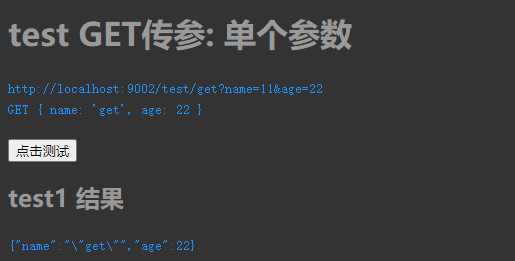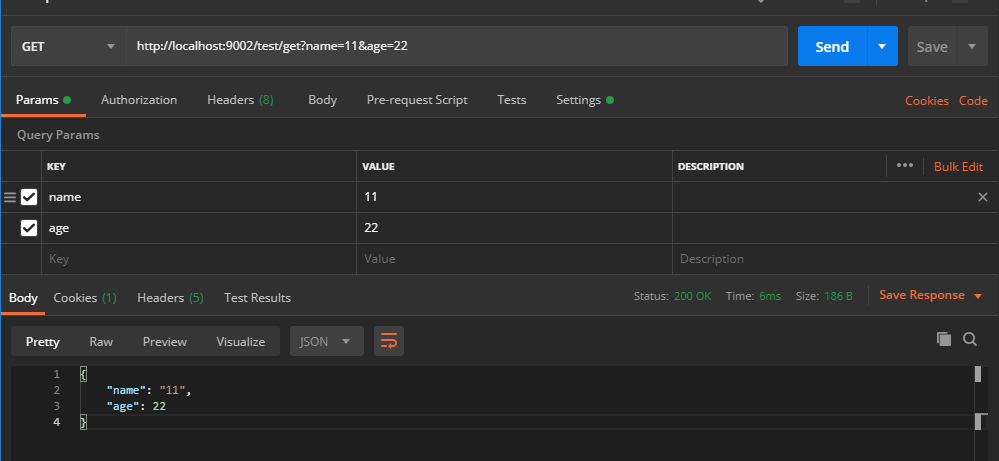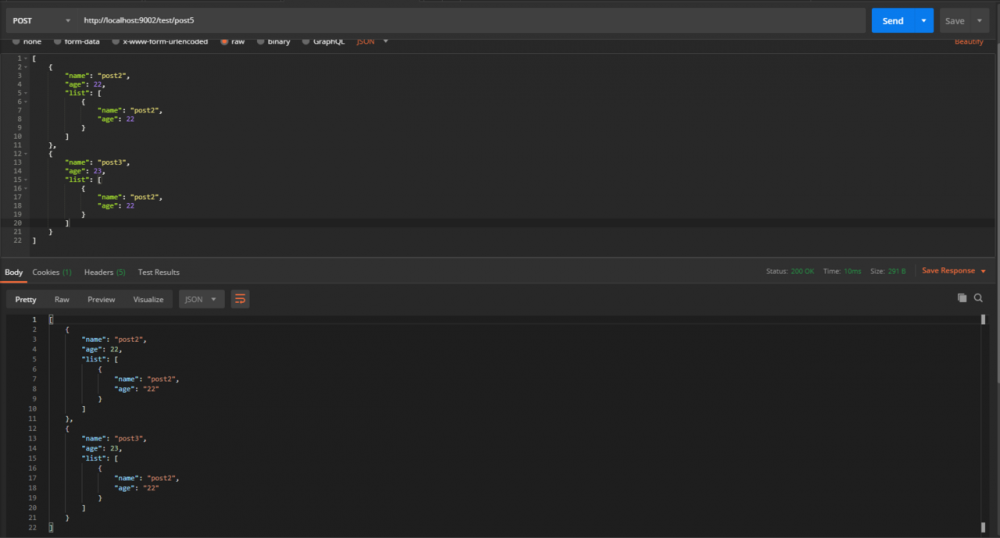spring Boot手把手教学(10): 前后端传参接收的N种方式
- 1、前言
- 2、请求参数
- 3、实例分析
- 3.1 GET 路径参数
- 3.2 GET 单个参数
- 3.3 GET 接收参数为List
- 3.4 POST单个接收参数
- 3.5 POST参数为List
- 4、完整代码
实际项目中,大多数项目,前后端是分离的。 前端发HTTP请求到后端Server ,然后后端接收参数做相应业务逻辑。
❝
首先先说下请求类型:
❞
GET GET方法请求一个指定资源的表示形式. 使用GET的请求应该只被用于获取数据.
HEAD HEAD方法请求一个与GET请求的响应相同的响应,但没有响应体.
POST POST方法用于将实体提交到指定的资源,通常导致在服务器上的状态变化或副作用.
PUT PUT方法用请求有效载荷替换目标资源的所有当前表示。
DELETE DELETE方法删除指定的资源。
CONNECT CONNECT方法建立一个到由目标资源标识的服务器的隧道。
OPTIONS OPTIONS方法用于描述目标资源的通信选项。
TRACE TRACE方法沿着到目标资源的路径执行一个消息环回测试。
PATCH PATCH方法用于对资源应用部分修改。
实际上常用的类型也就是 GET和POST,GET是从服务器获取资源,POST是提交资料到服务器 ;
不过很多开发的同学,都不区分两者的区别,最好还是区分一下,两者毕竟有所不同;
那么HTTP 请求都有什么类型的参数呢?
2、请求参数
大多有这三类请求参数类型:
-
(GET)请求路径参数用
@PathVariable: http://localhost:9002/test/user/{userId} -
(GET)URL中存在查询参数用
@RequestParam: http://localhost:9002/test/get?name=11&age=22 -
(POST) 参数存在于request body中用
@RequestBody: 参数可能是Object, 也可能是List
3、实例分析
我们这里不使用前端的任何框架,以纯JS的形式,去封装一个HTTP方法,发送HTTP请求 ;
❝
src/main/resources/templates/js/test.js
❞
//封装HTTP请求方法
const http = {
// 请求方法
request: (params = {}) => {
// 默认参数和参数合并
const requestParams = Object.assign({
type: 'GET',
url: '',
dateType: 'json',//请求返回结果类型
data: {
// 请求参数
},
headers: {
// 请求头
},
callback0: () => {
// 报文成功返回后回调
}
}, params);
// 请求
const xhr = new XMLHttpRequest();
// 请求方法
const {type, data, url, headers} = requestParams;
const requestMethod = ('' + type).toLocaleLowerCase();
// url 是否携带参数
const urlHasParams = requestMethod === 'get';
const requestUrl = urlHasParams ? http.getUrlString(url, data) : url;
// 参数类型
const dataType = Object.prototype.toString.apply(data);
xhr.open(type, requestUrl);
if (dataType === '[object Array]') {
xhr.setRequestHeader("Content-type", "application/json; charset=utf-8");
}
// 自定义表头
Object.keys(headers).forEach(m => {
xhr.setRequestHeader(m, headers[m]);
});
xhr.addEventListener("load", e => {
const status = xhr.status;
if (status === 200) {
requestParams.callback0(xhr.response);
} else {
console.log(e);
}
});
xhr.send(urlHasParams ? null : http.getFormData(data));
},
// Object 转化为 String
getQueryString: (data = {}) => {
let _r = [];
Object.keys(data).forEach(m => {
_r.push(`${m}=${JSON.stringify(data[m])}`);
});
_r = _r.join('&');
return _r;
},
// GET 请求,参数合并到URL上
getUrlString: (url, data) => {
return url.includes('?') ? url + '&' + http.getQueryString(data) : url + '?' + http.getQueryString(data);
},
// formData
getFormData: data => {
const dataType = Object.prototype.toString.apply(data);
// Object
if (dataType === '[object Object]') {
const formData = new FormData();
Object.keys(data).forEach(m => {
formData.append(m, data[m]);
});
return formData;
} else {
// Array
return JSON.stringify(data);
}
}
};
复制代码
3.1 GET 路径参数
❝
com.scaffold.test.controller.TestController
❞
// 路径
@GetMapping("/path/{id}")
public Object testId(@PathVariable String id, @RequestParam String name) {
Map<String, Object> map = new HashMap<>();
map.put("id", id);
map.put("name", name);
return map;
}
复制代码
@PathVariable 去接收路径参数;
❝
html
❞
<!--GET: 路径中携带参数-->
<h1>test GET: 路径中携带参数</h1>
<code>http://localhost:9002/test/path/6666?name=11</code>
<br>
<code>
GET
{
name: '11'
}
</code>
<br/>
<br/>
<button onclick="testPath()">点击测试</button>
<h2>testPath 结果</h2>
<code class="testPathResult"></code>
复制代码
❝
js
❞
// Get 参数存在于路径中
const testPath = () => {
http.request({
url: '/test/path/6666',
type: 'get',
data: {
name: '111',
},
callback0: data => {
document.querySelector('.testPathResult').innerHTML = data;
}
})
};
复制代码
结果 

3.2 GET 单个参数
GET请求,参数都会附加到URL上 ,如: http://localhost:9002/test/get?name=11&age=22
@GetMapping("/get")
public Object testGet(@RequestParam String name, @RequestParam int age) {
Map<String, Object> result = new HashMap<>();
// 数据处理
result.put("name", name);
result.put("age", age);
return result;
}
复制代码
❝
html
❞
<!--GET: 单个参数-->
<h1>test GET传参: 单个参数</h1>
<code>http://localhost:9002/test/get?name=11&age=22</code>
<br>
<code>
GET
{
name: 'get',
age: 22
}
</code>
<br/>
<br/>
<button onclick="test1()">点击测试</button>
<h2>test1 结果</h2>
<code class="test1Result"></code>
<br>
复制代码
❝
js
❞
// GET 参数类型为 Object
const test1 = () => {
http.request({
url: '/test/get',
type: 'get',
data: {
name: 'get',
age: 22
},
callback0: data => {
document.querySelector('.test1Result').innerHTML = data;
}
})
};
复制代码
结果 

3.3 GET 接收参数为List
有时候前端需要传多个ID,如 productId=1,2,3
// 数组接收
@GetMapping("/getList")
public Object testGet4(@RequestParam String[] productId) {
ArrayList<Object> list = new ArrayList<>();
for (String id : productId) {
// 数据处理
list.add(id);
}
return list;
}
复制代码
❝
html
❞
<!--GET: 参数数组-->
<h1>test GET传参: 数组</h1>
<code>http://localhost:9002/test/getList?productId=1,2,3</code>
<br>
<code>
GET
{
productId: 1,2,3
}
</code>
<br/>
<br/>
<button onclick="test4()">点击测试</button>
<h2>test4 结果</h2>
<code class="test4Result"></code>
<br>
复制代码
❝
js
❞
// GET 获取数组ID
const test4 = () => {
http.request({
url: '/test/getList',
type: 'get',
data: {
productId: '1,2,3'
},
callback0: data => {
document.querySelector('.test4Result').innerHTML = data;
}
})
};
复制代码
结果 

3.4 POST单个接收参数
POST请求和GET请求不同,POST请求一般是是在response body里面的;
❝
POST请求参数处理:
❞
// formData
getFormData: data => {
const dataType = Object.prototype.toString.apply(data);
// Object
if (dataType === '[object Object]') {
const formData = new FormData();
Object.keys(data).forEach(m => {
formData.append(m, data[m]);
});
return formData;
} else {
// Array
return JSON.stringify(data);
}
}
复制代码
如果参数是Object, 用FromData的格式进行传参 ,用 @RequestParam 接收;
如果参数是Object, 序列化数据直接进行传参(需指定Content-type:application/json; charset=utf-8) ;
❝
这里我们先说,POST单个接收参数,也就是POST的参数是Object, 一个个接收;
❞
// 单个参数接收
@PostMapping("/post")
public Object testPost(@RequestParam String name, @RequestParam int age) {
Map<String, Object> result = new HashMap<>();
// 数据处理
result.put("name", name);
result.put("age", age);
return result;
}
复制代码
❝
注意:
当前接收方式,前端必须是FromData格式进行传参;
当前Content-type是 Content-Type: multipart/form-data; boundary=----WebKitFormBoundaryNB8kMuHgB1nEVjBz
❞
单个接收参数,在参数过多时,不适合这种写法;
❝
这时,我们可以用实体类接收:
❞
// 实体类接收:不加注解
@PostMapping("/post22")
public Object testPost22(Test data) {
Map<String, Object> result = new HashMap<>();
// 数据处理
result.put("name", data.getName());
result.put("age", data.getAge());
return result;
}
复制代码
我们可以用 不加注解的方式用实体类接收 ,这时候一定不能加注解 @RequestBody ;
❝
实体类Test
❞
public class Test implements Serializable {
private static final long serialVersionUID=1L;
@TableId(value = "id", type = IdType.AUTO)
private Integer id;
private String name;
private String age;
}
复制代码
FromData参数形式Content-type是multipart/form-data;而 @RequestBody,一般是接收Content-type是application/json的参数,如果你在这里使用了@RequestBody,一定会报一下错误 :
{"code":400,"message":"Content type 'multipart/form-data;boundary=----WebKitFormBoundarymrp2iCvqhwa3oMaR;charset=UTF-8' not supported"}
复制代码
如果我们一定要使用 @RequestBody 接收参数,一定要记得设置Content-Type为application/json;
// @RequestBody 实体类接收
@PostMapping("/post23")
public Object testPost2(@RequestBody Test data) {
Map<String, Object> result = new HashMap<>();
// 数据处理
result.put("name", data.getName());
result.put("age", data.getAge());
return result;
}
复制代码
所以,
为了方便测试,我们对HTTP请求方法做出了以下更改:
// formData
getFormData: data => {
const dataType = Object.prototype.toString.apply(data);
// Object
// isFromData标注是否使用FromData方式发送参数
if (dataType === '[object Object]' && data.isFromData) {
const formData = new FormData();
Object.keys(data).forEach(m => {
formData.append(m, data[m]);
});
return formData;
} else {
// Array || Object(JSON格式传参)
return JSON.stringify(data);
}
}
// @ResponseBody注解,接收参数时,必须是application/json
// POST请求不以FromData格式时
if (dataType === '[object Array]' || (requestMethod == 'post' && !data.isFromData)) {
xhr.setRequestHeader("Content-type", "application/json; charset=utf-8");
}
复制代码
❝
同时测试三种方法接受参数:
❞
// @RequestParam 单个参数接收------前端使用FromData
@PostMapping("/post")
public Object testPost(@RequestParam String name, @RequestParam int age) {
Map<String, Object> result = new HashMap<>();
// 数据处理
result.put("name", name);
result.put("age", age);
return result;
}
// 实体类接收:不加注解------前端使用FromData
@PostMapping("/post22")
public Object testPost22(Test data) {
Map<String, Object> result = new HashMap<>();
// 数据处理
result.put("name", data.getName());
result.put("age", data.getAge());
return result;
}
// @RequestBody 实体类接收------前端不使用FromData
@PostMapping("/post23")
public Object testPost2(@RequestBody Test data) {
Map<String, Object> result = new HashMap<>();
// 数据处理
result.put("name", data.getName());
result.put("age", data.getAge());
return result;
}
复制代码
❝
html
❞
<!--POST:单个参数,FromData格式-->
<h1>test POST:单个参数,FromData格式</h1>
<code>
POST
{
name: 'post',
age: 22
}
</code>
<br/>
<br/>
<button onclick="test2()">点击测试</button>
<h2>test2 结果</h2>
<code class="test2Result"></code>
<br>
<hr><!--POST:单个参数,以JSON格式发送-->
<h1>test POST:单个参数,以JSON格式发送</h1>
<code>
POST
{
name: 'post',
age: 23
}
</code>
<br/>
<br/>
<button onclick="test23()">点击测试</button>
<h2>test23 结果</h2>
<code class="test23Result"></code>
<br>
<hr>
复制代码
❝
js
❞
// post 参数类型为 Object, FromData格式发送
const test2 = () => {
http.request({
url: '/test/post',
type: 'post',
data: {
name: 'post',
age: 22,
isFromData: true
},
callback0: data => {
document.querySelector('.test2Result').innerHTML = data;
}
})
};
// post 参数类型为 Object, FromData格式发送
const test22 = () => {
http.request({
url: '/test/post22',
type: 'post',
data: {
name: 'post',
age: 22,
isFromData: true
},
callback0: data => {
document.querySelector('.test2Result').innerHTML = data;
}
})
};
// post 参数类型为 Object, 以JSON格式发送
const test23 = () => {
http.request({
url: '/test/post23',
type: 'post',
data: {
name: 'post',
age: 23,
isFromData: false
},
callback0: data => {
document.querySelector('.test23Result').innerHTML = data;
}
})
};
复制代码
❝
结果
❞

3.5 POST参数为List
参数类型List时候,请求头Content-Type设置为application/json;使用@RequestBody注解;
3.5.1 List 类型1
❝
当参数类型List为:此时单个list中有单个Map, Map里面没有List
❞
[
{
name: 'post2',
age: 22
},
{
name: 'post3',
age: 23
}
]
复制代码
// 数组接收
@PostMapping("/post3")
public Object testPost3(@RequestBody List<Test> data) {
ArrayList<Object> result = new ArrayList<>();
Map<String, Object> testMap = new HashMap<>();
for (Test test : data) {
// 逻辑处理在这里
testMap.put("name", test.getName());
testMap.put("age", test.getAge());
result.add(testMap);
}
return result;
}
复制代码
此时的实体类:com.scaffold.test.entity.Test
@Data
@EqualsAndHashCode(callSuper = false)
@JsonInclude(JsonInclude.Include.NON_NULL)
public class Test implements Serializable {
private static final long serialVersionUID=1L;
@TableId(value = "id", type = IdType.AUTO)
private Integer id;
private String name;
private String age;
}
复制代码
此时的html :
<!--POST: 数组(纯数组)-->
<h1>test POST: 数组(纯数组)</h1>
<code>
POST
[
{
name: 'post2',
age: 22
},
{
name: 'post3',
age: 23
}
]
</code>
<br/>
<br/>
<button onclick="test3()">点击测试</button>
<h2>test3 结果</h2>
<code class="test3Result"></code>
<br>
<hr>
复制代码
此时的Js :
// POST 参数类型为 list
const test3 = () => {
http.request({
url: '/test/post3',
type: 'post',
data: [
{
name: 'post2',
age: 22
},
{
name: 'post3',
age: 23
}
],
callback0: data => {
document.querySelector('.test3Result').innerHTML = data;
}
})
};
复制代码
结果 

3.5.2 list 类型2
[
{
"name": "post2",
"age": 22,
"list": [
{
"name": "post22",
"age": 2233
}
]
},
{
"name": "post3",
"age": 23,
"list": [
{
"name": "post33",
"age": 2233
}
]
}
]
复制代码
❝
此时我们的实体类:com.scaffold.test.entity.TestList
❞
@Data
@JsonInclude(JsonInclude.Include.NON_NULL)
public class TestList {
private String name;
private int age;
private List<Test> list;
}
复制代码
// 数组接收, map里面还有数组类型
@PostMapping("/post5")
public Object testPost5(@RequestBody List<TestList> testList) {
return testList;
}
复制代码
❝
html
❞
<!--POST传参: 数组中有map, map中还包括数组-->
<h1>test POST传参: 数组中有map, map中还包括数组</h1>
<code>
POST
[
{
name: 'post2',
age: 22,
list: [
{
name: 'post22',
age: 2233,
}
]
},
{
name: 'post3',
age: 23,
list: [
{
name: 'post33',
age: 2233,
}
]
}
]
</code>
<br/>
<br/>
<button onclick="test5()">点击测试</button>
<h2>test5 结果</h2>
<code class="test5Result"></code>
<br>
<hr>
复制代码
❝
js
❞
// 测试方法5
const test5 = () => {
http.request({
url: '/test/post5',
type: 'post',
data: [
{
name: 'post2',
age: 22,
list: [
{
name: 'post22',
age: 2233,
}
]
},
{
name: 'post3',
age: 23,
list: [
{
name: 'post33',
age: 2233,
}
]
}
],
callback0: data => {
document.querySelector('.test5Result').innerHTML = data;
}
})
};
复制代码
❝
结果
❞


4、完整代码
❝
src/main/resources/templates/js/test.js
❞
//封装HTTP请求方法
const http = {
// 请求方法
request: (params = {}) => {
// 默认参数和参数合并
const requestParams = Object.assign({
type: 'GET',
url: '',
dateType: 'json',//请求返回结果类型
data: {
// 请求参数
},
headers: {
// 请求头
},
callback0: () => {
// 报文成功返回后回调
}
}, params);
// 请求
const xhr = new XMLHttpRequest();
// 请求方法
const {type, data, url, headers} = requestParams;
const requestMethod = ('' + type).toLocaleLowerCase();
// url 是否携带参数
const urlHasParams = requestMethod === 'get';
const requestUrl = urlHasParams ? http.getUrlString(url, data) : url;
// 参数类型
const dataType = Object.prototype.toString.apply(data);
xhr.open(type, requestUrl);
// @ResponseBody注解,接收参数时,必须是application/json
// POST请求不以FromData格式时
if (dataType === '[object Array]' || (requestMethod == 'post' && !data.isFromData)) {
xhr.setRequestHeader("Content-type", "application/json; charset=utf-8");
}
// 自定义表头
Object.keys(headers).forEach(m => {
xhr.setRequestHeader(m, headers[m]);
});
xhr.addEventListener("load", e => {
const status = xhr.status;
if (status === 200) {
requestParams.callback0(xhr.response);
} else {
console.log(e);
}
});
xhr.send(urlHasParams ? null : http.getFormData(data));
},
// Object 转化为 String
getQueryString: (data = {}) => {
let _r = [];
Object.keys(data).forEach(m => {
_r.push(`${m}=${JSON.stringify(data[m])}`);
});
_r = _r.join('&');
return _r;
},
// GET 请求,参数合并到URL上
getUrlString: (url, data) => {
return url.includes('?') ? url + '&' + http.getQueryString(data) : url + '?' + http.getQueryString(data);
},
// formData
getFormData: data => {
const dataType = Object.prototype.toString.apply(data);
// Object
// isFromData标注是否使用FromData方式发送参数
if (dataType === '[object Object]' && data.isFromData) {
const formData = new FormData();
Object.keys(data).forEach(m => {
formData.append(m, data[m]);
});
return formData;
} else {
// Array || Object(JSON格式传参)
return JSON.stringify(data);
}
}
};
// GET 参数类型为 Object
const test1 = () => {
http.request({
url: '/test/get',
type: 'get',
data: {
name: 'get',
age: 22
},
callback0: data => {
document.querySelector('.test1Result').innerHTML = data;
}
})
};
// Get 参数存在于路径中
const testPath = () => {
http.request({
url: '/test/path/6666',
type: 'get',
data: {
name: '111',
},
callback0: data => {
document.querySelector('.testPathResult').innerHTML = data;
}
})
};
// post 参数类型为 Object, FromData格式发送
const test2 = () => {
http.request({
url: '/test/post',
type: 'post',
data: {
name: 'post',
age: 22,
isFromData: true
},
callback0: data => {
document.querySelector('.test2Result').innerHTML = data;
}
})
};
// post 参数类型为 Object, FromData格式发送
const test22 = () => {
http.request({
url: '/test/post22',
type: 'post',
data: {
name: 'post',
age: 22,
isFromData: true
},
callback0: data => {
document.querySelector('.test2Result').innerHTML = data;
}
})
};
// post 参数类型为 Object, 以JSON格式发送
const test23 = () => {
http.request({
url: '/test/post23',
type: 'post',
data: {
name: 'post',
age: 23,
isFromData: false
},
callback0: data => {
document.querySelector('.test23Result').innerHTML = data;
}
})
};
// POST 参数类型为 list
const test3 = () => {
http.request({
url: '/test/post3',
type: 'post',
data: [
{
name: 'post2',
age: 22
},
{
name: 'post3',
age: 23
}
],
callback0: data => {
document.querySelector('.test3Result').innerHTML = data;
}
})
};
// GET 获取数组ID
const test4 = () => {
http.request({
url: '/test/getList',
type: 'get',
data: {
productId: '1,2,3'
},
callback0: data => {
document.querySelector('.test4Result').innerHTML = data;
}
})
};
// 获取请求头数据
const testHeader = () => {
http.request({
url: '/test/header',
type: 'post',
headers: {
privateHeader: "test88888",
privateHeader2: "test888882",
},
callback0: data => {
document.querySelector('.testHeaderResult').innerHTML = data;
}
})
};
// 获取所有请求头数据
const testHeaders = () => {
http.request({
url: '/test/headers',
type: 'get',
headers: {
privateHeader: "test888881",
privateHeader2: "test888882",
privateHeader3: "test888883",
},
callback0: data => {
document.querySelector('.testHeadersResult').innerHTML = data;
}
})
};
// 测试方法5
const test5 = () => {
http.request({
url: '/test/post5',
type: 'post',
data: [
{
name: 'post2',
age: 22,
list: [
{
name: 'post22',
age: 2233,
}
]
},
{
name: 'post3',
age: 23,
list: [
{
name: 'post33',
age: 2233,
}
]
}
],
callback0: data => {
document.querySelector('.test5Result').innerHTML = data;
}
})
};
复制代码
❝
src/main/resources/templates/test.html
❞
<!DOCTYPE html>
<html lang="en">
<head>
<meta charset="UTF-8">
<title>Test</title>
<style>
body {
background: #333;
color: #999;
}
hr {
border: none;
height: 1px;
background: #999;
}
code {
color: dodgerblue;
}
</style>
</head>
<body>
<!--GET: 单个参数-->
<h1>test GET传参: 单个参数</h1>
<code>http://localhost:9002/test/get?name=11&age=22</code>
<br>
<code>
GET
{
name: 'get',
age: 22
}
</code>
<br/>
<br/>
<button onclick="test1()">点击测试</button>
<h2>test1 结果</h2>
<code class="test1Result"></code>
<br>
<hr>
<!--GET: 路径中携带参数-->
<h1>test GET: 路径中携带参数</h1>
<code>http://localhost:9002/test/path/6666?name=11</code>
<br>
<code>
GET
{
name: '11'
}
</code>
<br/>
<br/>
<button onclick="testPath()">点击测试</button>
<h2>testPath 结果</h2>
<code class="testPathResult"></code>
<br>
<hr>
<!--GET: 参数数组-->
<h1>test GET传参: 数组</h1>
<code>http://localhost:9002/test/getList?productId=1,2,3</code>
<br>
<code>
GET
{
productId: 1,2,3
}
</code>
<br/>
<br/>
<button onclick="test4()">点击测试</button>
<h2>test4 结果</h2>
<code class="test4Result"></code>
<br>
<hr>
<!--GET || POST : 获取请求头中数据-->
<h1>test GET || POST : 获取请求头中数据</h1>
<code>http://localhost:9002/test/header</code>
<br>
<code>
GET || POST
headers: {
privateHeader: "test88888",
privateHeader2: "test888882",
}
</code>
<br/>
<br/>
<button onclick="testHeader()">点击测试</button>
<h2>testHeader 结果</h2>
<code class="testHeaderResult"></code>
<br>
<hr>
<!--GET || POST: 获取请求头中所有的数据-->
<h1>test GET || POST : 获取请求头中所有的数据</h1>
<code>http://localhost:9002/test/headers</code>
<br>
<code>
GET || POST
headers: {
privateHeader: "test888881",
privateHeader2: "test888882",
privateHeader3: "test888883",
}
</code>
<br/>
<br/>
<button onclick="testHeaders()">点击测试</button>
<h2>testHeaders 结果</h2>
<code class="testHeadersResult"></code>
<br>
<hr>
<!--POST:单个参数,FromData格式-->
<h1>test POST:单个参数,FromData格式</h1>
<code>
POST
{
name: 'post',
age: 22
}
</code>
<br/>
<br/>
<button onclick="test2()">点击测试</button>
<h2>test2 结果</h2>
<code class="test2Result"></code>
<br>
<hr><!--POST:单个参数,以JSON格式发送-->
<h1>test POST:单个参数,以JSON格式发送</h1>
<code>
POST
{
name: 'post',
age: 23
}
</code>
<br/>
<br/>
<button onclick="test23()">点击测试</button>
<h2>test23 结果</h2>
<code class="test23Result"></code>
<br>
<hr>
<!--POST: 数组(纯数组)-->
<h1>test POST: 数组(纯数组)</h1>
<code>
POST
[
{
name: 'post2',
age: 22
},
{
name: 'post3',
age: 23
}
]
</code>
<br/>
<br/>
<button onclick="test3()">点击测试</button>
<h2>test3 结果</h2>
<code class="test3Result"></code>
<br>
<hr>
<!--POST传参: 数组中有map, map中还包括数组-->
<h1>test POST传参: 数组中有map, map中还包括数组</h1>
<code>
POST
[
{
name: 'post2',
age: 22,
list: [
{
name: 'post22',
age: 2233,
}
]
},
{
name: 'post3',
age: 23,
list: [
{
name: 'post33',
age: 2233,
}
]
}
]
</code>
<br/>
<br/>
<button onclick="test5()">点击测试</button>
<h2>test5 结果</h2>
<code class="test5Result"></code>
<br>
<hr>
<script src="./js/test.js"></script>
</body>
</html>
复制代码
❝
com.scaffold.test.controller.TestController
❞
package com.scaffold.test.controller;
import com.scaffold.test.entity.Test;
import com.scaffold.test.entity.TestList;
import org.slf4j.Logger;
import org.slf4j.LoggerFactory;
import org.springframework.web.bind.annotation.*;
import javax.servlet.http.HttpServletRequest;
import java.util.ArrayList;
import java.util.HashMap;
import java.util.List;
import java.util.Map;
/**
* <p>
* 前端控制器
* </p>
*
* @author alex wong
* @since 2020-06-23
*/
@RestController
@RequestMapping("/test")
public class TestController {
private static final Logger log = LoggerFactory.getLogger(TestController.class);
@GetMapping("/get")
public Object testGet(@RequestParam String name, @RequestParam int age) {
Map<String, Object> result = new HashMap<>();
// 数据处理
result.put("name", name);
result.put("age", age);
return result;
}
// 数组接收
@GetMapping("/getList")
public Object testGet4(@RequestParam String[] productId) {
ArrayList<Object> list = new ArrayList<>();
for (String id : productId) {
// 数据处理
list.add(id);
}
return list;
}
// 路径
@GetMapping("/path/{id}")
public Object testId(@PathVariable String id, @RequestParam String name) {
Map<String, Object> map = new HashMap<>();
map.put("id", id);
map.put("name", name);
return map;
}
// @RequestParam 单个参数接收------前端使用FromData
@PostMapping("/post")
public Object testPost(@RequestParam String name, @RequestParam int age) {
Map<String, Object> result = new HashMap<>();
// 数据处理
result.put("name", name);
result.put("age", age);
return result;
}
// 实体类接收:不加注解------前端使用FromData
@PostMapping("/post22")
public Object testPost22(Test data) {
Map<String, Object> result = new HashMap<>();
// 数据处理
result.put("name", data.getName());
result.put("age", data.getAge());
return result;
}
// @RequestBody 实体类接收
@PostMapping("/post23")
public Object testPost23(@RequestBody Test data) {
Map<String, Object> result = new HashMap<>();
// 数据处理
result.put("name", data.getName());
result.put("age", data.getAge());
return result;
}
// 数组接收
@PostMapping("/post3")
public Object testPost3(@RequestBody List<Test> data) {
ArrayList<Object> result = new ArrayList<>();
Map<String, Object> testMap = new HashMap<>();
for (Test test : data) {
// 逻辑处理在这里
testMap.put("name", test.getName());
testMap.put("age", test.getAge());
result.add(testMap);
}
return result;
}
// 数组接收, map里面还有数组类型
@PostMapping("/post5")
public Object testPost5(@RequestBody List<TestList> testList) {
return testList;
}
// 获取请求头
@RequestMapping("/header")
public Object getHeader(@RequestHeader(name = "privateHeader") String privateHeader, @RequestHeader(name = "privateHeader2") String privateHeader2) {
HashMap<Object, Object> map = new HashMap<>();
map.put("privateHeader", privateHeader);
map.put("privateHeader2", privateHeader2);
return map;
}
// 获取所有的请求头
@RequestMapping("/headers")
public Object getAllHeader(HttpServletRequest request) {
Map<Object, Object> resultHeader = new HashMap<>();
resultHeader.put("privateHeader", request.getHeader("privateHeader"));
resultHeader.put("privateHeader2", request.getHeader("privateHeader2"));
resultHeader.put("privateHeader3", request.getHeader("privateHeader3"));
return resultHeader;
}
// 获取Cookie
@RequestMapping("/cookie")
public Object getCookie(@CookieValue(name = "token") String token) {
return token;
}
}
复制代码
❝
实体类
❞
❝
com.scaffold.test.entity.Test
❞
package com.scaffold.test.entity;
import com.baomidou.mybatisplus.annotation.IdType;
import com.baomidou.mybatisplus.annotation.TableId;
import com.fasterxml.jackson.annotation.JsonInclude;
import lombok.Data;
import lombok.EqualsAndHashCode;
import java.io.Serializable;
/**
* @author alex wong
* @since 2020-06-23
*/
@Data
@EqualsAndHashCode(callSuper = false)
@JsonInclude(JsonInclude.Include.NON_NULL)
public class Test implements Serializable {
private static final long serialVersionUID=1L;
@TableId(value = "id", type = IdType.AUTO)
private Integer id;
private String name;
private String age;
}
复制代码
❝
com.scaffold.test.entity.TestList
❞
package com.scaffold.test.entity;
import com.fasterxml.jackson.annotation.JsonInclude;
import lombok.Data;
import java.util.List;
@Data
@JsonInclude(JsonInclude.Include.NON_NULL)
public class TestList {
private String name;
private int age;
private List<Test> list;
}
复制代码
本文使用 mdnice 排版
- 本文标签: REST ACE db ArrayList 数据 json final java MQ js HTML list 删除 tab HashMap UI 实例 开发 spring IO https tag App value http 测试 token map URLs 参数 ORM ip zab CTO key entity 服务器 Spring Boot cat Select mybatis message servlet equals 代码 XML src web id Document
- 版权声明: 本文为互联网转载文章,出处已在文章中说明(部分除外)。如果侵权,请联系本站长删除,谢谢。
- 本文海报: 生成海报一 生成海报二











![[HBLOG]公众号](https://www.liuhaihua.cn/img/qrcode_gzh.jpg)

